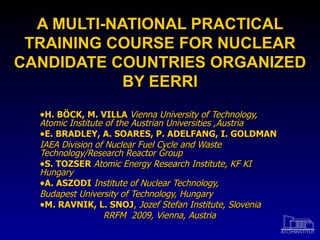Mulitnat Training Course
- 1. A MULTI-NATIONAL PRACTICAL TRAINING COURSE FOR NUCLEAR CANDIDATE COUNTRIES ORGANIZED BY EERRI H. B├ЦCK, M. VILLA Vienna University of Technology, Atomic Institute of the Austrian Universities ,Austria E. BRADLEY, A. SOARES, P. ADELFANG, I. GOLDMAN IAEA Division of Nuclear Fuel Cycle and Waste Technology/Research Reactor Group S. TOZSER Atomic Energy Research Institute, KF KI Hungary A. ASZODI Institute of Nuclear Technology, Budapest University of Technology, Hungary M. RAVNIK, L. SNOJ , Jozef Stefan Institute, Slovenia RRFM 2009, Vienna, Austria
- 2. What is EERRI? E astern E uropean R esearch R eactor I nitiative Members: Austria : Vienna University of Technology/ Atominstitut, Czech Republic : Czech Technical University and Rez Nuclear Research Centre Hungary : KFKI Budapest Research Reactor and Budapest University of Technology and Economics Poland : Institute of Atomic Energy Maria Research Reactor Romania : INR Pitesti Triga Reactor Slovenia : Joszef Stefan Institute
- 3. Objectives Member States (MS) request IAEA assistance to develop nuclear skills and resources in support of national nuclear power programmes under development. Some of these MS plan to construct a research reactor as a first step to develop nuclear competence and infrastructure. Countries with little or no existing nuclear infrastructure, human resources and skills must be developed to support these planning activities EERRI was approached by the IAEA to organize and implement a Group Fellowship Training Program on Research Reactors (GFTPRR) to satisfy the increasing demand for that skill development. The GFTPRR will be offered to participants from MS who have expressed interest in this subject to the IAEA.
- 4. Objectives Course is organized in collaboration with the Vienna University of Technology/Atominstitute (VUT/ATI). The first iteration will involve VUT/ATI, two Hungarian Nuclear Research Institutes, and staff members from the Jozef Stefan Institute's/Ljubljana (IJS), Slovenia as well as the IAEA. The duration of the training program will be 6 weeks and cover about 30 topics ranging from theoretical lectures to practical experiments : Organisational Matters Research Reactor Operation and Maintenance Radiation Protection The first training course is planned for spring 2009 with six participants.
- 5. Vienna University of Technology/Atominstitute (VUT/ATI), Austria Practical Exercises in Reactor Physics and Kinetics Practical exercises in Reactor Instrumentation and Control Practical Exercises in Radiation Protection and Dosimetry
- 6. 250 kW TRIGA Mark II reactor Vienna
- 7. KFKI Budapest, Hungary Research Reactor operation and utilization matters Water chemistry in general and in practice at BRR Emergency procedures QA issues at a research reactor and practical approaches of nuclear project planning and implementation
- 8. 10 MW KFKI Reactor Budapest
- 9. Budapest University of Technology, Hungary Thermal hydraulics Radiation protection and waste management Site requirements Public information
- 10. 100 kW training reactor Techical University of Budapest
- 11. Jozef Stefan Institute, Ljubljana, Slovenia Reactor calculation of TRIGA Mark II research reactor cores, TRIGLAV-W ( http:// www.rcp.ijs.si/triglav / ), Validation and verification of modern Monte Carlo computer codes, such as MCNP, WIMS-D computer code together with other home-developed codes Calculation of various research reactor physics parameters and models Basics of burn-up calculations and core optimization .
- 12. 250 kW TRIGA reactor Jozef Stefan Institut Ljubljana
- 13. 1st week Vienna IAEA Day 1: Admin.Procedures, Strategic planning for RR Day 2: Code of Conduct for RR, Regulatory requirements Day 3: Safety requirements for RR, IAEA standards Day 4: Review & Evaluation of RR Safety Documents, Preparation of SAR Day 5:Test and discussion on week no 1,Visit to the Atominstitut & Admin Procedures
- 14. 2nd week Vienna ATI Day 6: Radiation Protection Procedures at a RR, Reactor Physics 1, Determination of the thermal neutron flux density in the TRIGA reactor Day 7: Reactor Physics 2, Power calibration and temperature coefficient Day 8: Critical experiment, Calibration of control rods, determination of reactivity worth and excess reactivity Day 9:RR I&C systems, Demonstration of I&C Detectors Day 10: Demonstration of fuel handling, Safeguarding RR, Test and discussion on week no 2
- 15. 3rd week Vienna ATI Day 11: RR Overview, RR Utilization, RR maintenance and in-service inspections, RR Decommissioning Day 12:Waste management in RR, NPP-PWR overview Day 13:NPP-BWR overview, Other NPP (HTR,LMFBR,GEN IV) Day 14: Public Information, Physical security Day 15: Demonstration of prompt criticality, Test and discussion on week no 3
- 16. 4th week Vienna with staff from Ljubljana Day 16: Introduction to reactor calculations, Introduction to computer codes WIMS (demonstration and computer exercises) Day 17:RR reactor physics parameters and models, Introduction to computer codes - TRIGLAV (demonstration and computer exercises) Day 18: Calculation of RR safety parameters, Introduction to computer codes MCNP (demonstration and computer exercises) Day 19: Burn-up calculations and core optimization, Questions and problems from the participants (discussion and computer exercises) Day 20: Questions and problems from the participants (discussion and computer exercises), Questions and problems from the participants (discussion and computer exercises), Test and discussion on week 4
- 17. 5th week Budapest KFKI&TU Budapest Day 21: The BRR (VVR-1 0 MW) reactor as a tank type RR reactor, S ite visit BRR тАЩs utilization Day 22: RR management (operation and utilisation issues), Emergency procedures Day 23: Water chemistry in general and in practice at BRR Personal monitoring Environmental monitoring Day 24: Quality assurance in practice at a research reactorNuclear project planning and implementation Day 25: Site visit requirements, Public information Test and discussion on week 5
- 18. 6th week Budapest TU and Final Vienna, IAEA Day 26: Thermal Hydraulics Day 27: Waste Management Radiation Protection Day 28: Practical course in Radiation Protection and Dosimetry, Test and discussion on week 6 Day 29: Transfer from Budapest to Vienna Day 30: Final Course Discussion at the IAEA
- 19. Conclusions The EERRI course is an excellent example of a multi-national coalition with the aim to transfer knowledge from one region into another region It also shows the efficient cooperation between institution of different structure across borders in Central and Eastern Europe


















